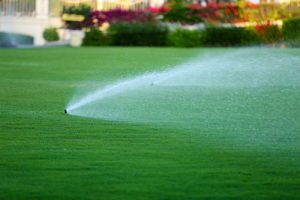Is Your Lawn Ready For Fall in the Midwest?
The end of summer doesn’t always mean you stop taking care of your lawn. As winter rapidly approaches, there is a high possibility that you are not spending most of your time thinking about your yard. However, autumn presents cooler temperatures and occasional rainfall, making it the perfect time to get your lawn ready for spring. Many homeowners think that their lawns do not need much care in the fall, considering that the grass grows more slowly. On the contrary, this is the time when lawn care has to be at its best.
During the fall season, grass busily absorbs energy, moisture, and nutrients while preparing for a long, dormant winter. All you have to do is give it attention now, and in return, you will get a lush, healthy spring lawn. The following are some fall lawn maintenance tips you should do to get your yard ready for fall:
Remove the Leaves
 If you leave the leaves unattended, they keep on piling up, and once you have mats of fallen leaves, they suffocate lawn grasses and invite diseases. If you want to get rid of the leaves, you can mow and mulch the small quantities of leaves. However, if they are in large amounts, you have no choice but to rake, bag, or compost them. Your lawn might be trimmed, but you are not doing it any good once you let the leaves all over. Not only do they affect the health of the leaves, but they also make the lawn look untidy.
If you leave the leaves unattended, they keep on piling up, and once you have mats of fallen leaves, they suffocate lawn grasses and invite diseases. If you want to get rid of the leaves, you can mow and mulch the small quantities of leaves. However, if they are in large amounts, you have no choice but to rake, bag, or compost them. Your lawn might be trimmed, but you are not doing it any good once you let the leaves all over. Not only do they affect the health of the leaves, but they also make the lawn look untidy.
Raking the leaves is always an excellent idea since the last thing you want is to wait until all the leaves have fallen from the trees. Doing so ends with wet leaves due to rain and morning dew, making them stick together, forming an impenetrable mat that suffocates the grass and breeds fungal diseases if you don’t do something about it. Alternatively, a lawnmower fitted with a collection bag or vacuum system is another method for removing the leaves from your lawn. It is effective if you are dealing with a large yard full of deciduous trees. Regardless of the technique you opt to use, all you need to do is get rid of the leaves before they become a soggy, suffocating mess as we approach fall.
Cut the Grass to the Correct Height
It is not time to put away your mower yet. For instance, if you have that warm-season grass, you should know that it will keep growing up to the first hard frost, so it will need regular cuts to keep it at the ideal 2½- to 3-inch height. Leaving your grass to grow tall only makes it mat and vulnerable to fungi such as snow mold.
On the other hand, cutting your grass too short is not good as well. It is as bad as leaving it to grow since it curtails the root system. Remember, the root depth is proportional to cutting height and makes it challenging for the lawn to withstand the winter cold and dryness. Likewise, mowing your yard often will help get rid of the pesky leaves, chopping them up, and you end up with a soil-enhancing munch. Ultimately, when you maintain your lawn grass with the appropriate height, not only does it benefit the grass itself, but it will provide you with that appealing look you would like for your lawn.
Aerate the Soil

If you do not know the best aeration option for your lawn, the best way is through core aeration, where you are required to pull small plugs of soil from the yard physically. Some lawn mowers come with an aerator attachment, but you do not have to rely on them entirely. You can still rent or purchase an aerator for this task. If you choose the renting avenue, have help handy. The machine can be significantly heavy and will need strength to move around as well as operate. If you are dealing with a small lawn, a manual aerator should get the job done.
Fertilize Your Lawn in the Fall
If you want to have the best lawn in the neighborhood or even throughout the town, you should consider fertilizing your lawn at least four times annually. However, if you can only do it once a year, fall is the best time to fertilize your lawn. Preferably, choose a fertilizer labeled 4-1-2. The numbers represent the nitrogen, phosphorus, and potassium percentages, respectively, present in your fertilizer. You can also consult with an expert in lawn fertilization for advice on the best fertilizer blend for your tall grass type and local soil conditions.
Remember, you can’t start fertilizing your lawn without knowing where to start. If you want your fertilizer to work optimally, apply it three weeks before the last mowing of the season. The primary reason why you should always fertilize your lawn in the fall is that it provides energy and nutrients for the grassroots while they are multiplying in the cooler weather before the grass goes dormant. Understandably, the roots also store food for the winter, giving the grass an initial growth spurt as it emerges from the spring dormancy.
Seed Your Lawn in the Fall
As part of your September lawn care, you should consider seeding your lawn. Most people will tell you that having a dense yard prevents weed infestation, which is true. Choosing to overseed your existing turf is an excellent decision. The good thing with overseeding is that it fills in thin spots or bare patches and also allows you to introduce the latest resilient and drought-tolerant grasses. Fall is the perfect time to overseed since the ground is still warm, there is more moisture, the nights are cool, and the sun is not pretty hot during the day. However, it may seem like it is a straightforward task, overseeding is arguably the most challenging lawn-care chore you will have to deal with.
Remember, you must ensure your seeds are in complete contact with the soil, keep them moist until they germinate, and be well established before the cold season gets into full swing. Unlike broadcasting the seeds, renting a slit seeder is a more convenient option, but those machines have a reputation for tearing up the turf and leaving the lawn looking like a harrowed field. Consider consulting with a lawn care expert to advise on the best method for injecting the seeds into the soil without leading to significant damage.
Keep Watering Your Lawn

If you don’t give your lawn at least an inch of water a week, you should ensure your sprinklers or the irrigation system is running until the end of October. You can use a simple rain gauge which is a more convenient way of keeping track of how your lawn gets watered. As part of your October lawn care, before the month ends, you should have disconnected the hoses and flush the irrigation system so that you don’t end up with frozen pipes and fixtures. Watering your lawn is vital to keep the grass hydrated and ready for whatever the fall season might throw at it. It may seem like one of the must-do chores, but when it is fall and with all the cool temperatures, it is a significantly overlooked activity, yet it should not be.
It is not uncommon to hear someone ask, “What should I do to my lawn in the fall?” Many people barely know how to take care of their yard, and it ends up costing them more than they realize. The above tips should help you prepare your lawn so that it’s in shape and ready for this daunting weather by the time fall comes. Remember, each of the tips listed has its appropriate time for the best results. If you do not do it when recommended, it will only be a waste of time and effort.
For instance, if you seed too late, the seedlings will not have grown well enough and will be too tender to make it through fall. Likewise, if you fertilize too early, your grass will send up tender blades that will get hammered by the cold. On the contrary, if you do it too late, the grassroots will not absorb all the nutrients you will feed them. Knowing what to do at the right time will spare you a lot of trouble in the future and will get your lawn in excellent shape as you prepare for fall.
Do You Need Some Help With Fall Lawn Care?
We would love to help you. Contact us today for help with your fall lawn care needs by a RYAN lawn care expert!









